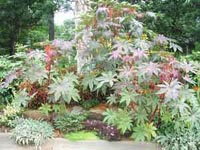Resource Library
Plant of the Week: Mole Bean, Castor Bean
The University of Arkansas System Division of Agriculture does not promote, support or recommend plants featured in "Plant of the Week." Please consult your local Extension office for plants suitable for your region.
Plant of the Week
[A-Z]
Castor Bean, Mole Bean
Latin: Ricinus communis

The bold look is back in garden design, so not surprisingly, castor beans have reappeared as backdrops for gardeners wanting to make a prominent statement in their plantings. Everything about castor bean is bold and a bit audacious, so gardeners with a bit of maverick in them seem to be drawn to this big plant.
What are the characteristics of the castor bean plant?
Castor bean (Ricinus communis) is a member of the spurge family and is native to tropical Africa where it grows as a tree to 40 feet tall. When grown as an annual it is usually a more modest 10 feet tall. Its leaves are star shaped with five to nine lobes and can be as large as a garbage can lid. The selections grown as ornamentals usually have a maroon tinge to the foliage.
Flowers
The flowers of castor bean are borne near the top of the plant in panicles. But lacking petals they are not especially noteworthy. As the seed mature, the three-celled, spiny capsules turn bright red on foot long panicles and make an interesting distraction to the bold foliage.
Seeds
The castor bean seed looks like an engorged dog tick in size and shape. It is from the extracts of this seed that castor bean gains its real significance. The oil is used commercially for everything from lubrication to cosmetics and is one of the most important industrial crop oils.
Like most children of my generation, my first encounter with castor oil was as a not-so-gentle laxative. The purgative powers of castor bean have long been known. The ancient Egyptians believed that food was the source of disease, so they drank beer laced with castor bean three times a month for a hearty flush of the digestive track.
As a teen-ager my encounter with castor bean expanded when I tried Castrol motor oil in hopes it would make my old Ford run like a race car. It didn’t help. The oil is used commercially in cosmetics, medicine and waterproofing treatments.
But castor bean seeds have one other characteristic that merits attention - they are poisonous. The poison is ricin, a proteinaceous molecule similar in structure and mode of action to the bacterial toxin found in anthrax. It’s said to be 1,000 times mote toxic than cobra venom.
Because of poor absorption of the phtotoxin from seed, fatalities from accidentally ingested seeds are uncommon. In fact, I can find no direct reports of fatalities from the seeds unless some nefarious plot was at work. But prudence dictates that castor bean plants should not be planted if small children are around.
Ricin has its own footnote in Cold War history. Georgi Markov (1929 - 1978), a dissident Bulgarian journalist who worked for the BBC and Radio Free Europe earned the animosity of Bulgarian State Security.
After his mysterious death in 1978, Scotland Yard investigated and found embedded in his leg a BB that had been cross-drilled with holes. The BB was fired from an umbrella rigged as a pellet rifle while Markov stood in line at a bus stop. The holes in the BB had been packed with ricin.
Three schemes were uncovered in the US between 1991 and 1997 in which ricin was intended to be used in murder. The most notorious of these involved a separatist organization in Minnesota that plotted to assassinate a local U.S. marshal by dosing the doorknob of his home with the poison.
Castor beans, despite their colorful history, are still good garden plants. They are best used at the back of the flower border where they form a fast growing, bold screen. Seeds should be planted where the plant is to stand in mid spring after the last chance of frost is past. They do best in full sun in any good garden soil. They are intolerant of wet locations.
By: Gerald Klingaman, retired
Extension Horticulturist - Ornamentals
Extension News - October 4, 2002
The University of Arkansas System Division of Agriculture does not maintain lists of retail outlets where these plants can be purchased. Please check your local nursery or other retail outlets to ask about the availability of these plants for your growing area.